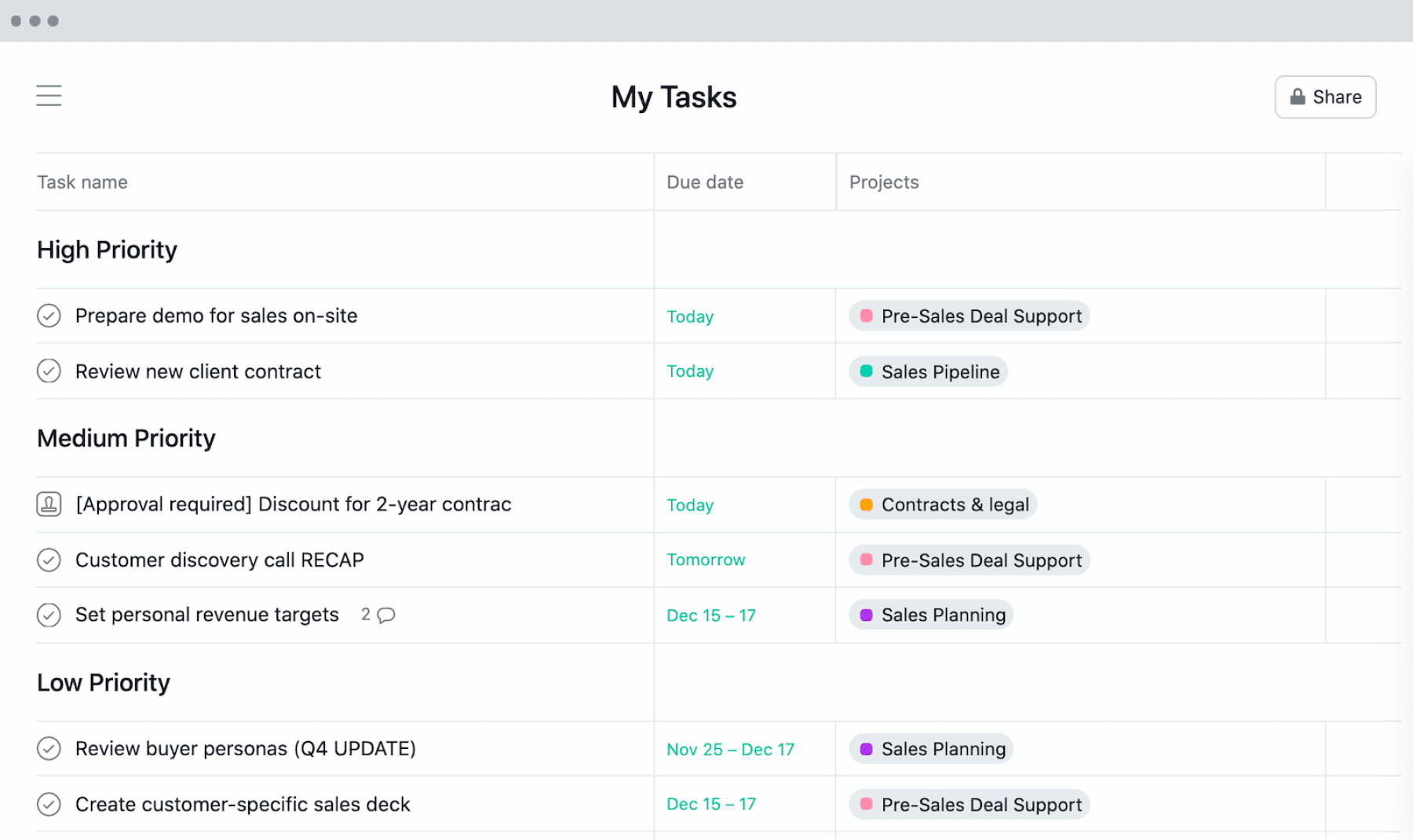
Everyone loves checking things off a 'to-do' list... but if it’s not done right, your task list can cause more harm than good.
Rachel Jenkins, Director of 22 Century Design & Marketing.
A to-do list is exactly what it says on the tin… a list of things you have to-do. That means basically anything and everything can be on your to-do list, but just because you’ve written your to-dos down doesn’t mean your to-do list is actually useful.
Effectively tracking when your work is due can help you prioritise and structure your workday. But too often, that list of work tasks is often disorganised and disconnected from the actual work you’re doing, which leads to less clarity and more work about work instead of actually working, confused? Me too!
The good news is, writing a to-do list doesn’t have to be an exercise in futility. Take control of your to-dos with these secrets for making a to-do list that actually works using Asana.
First thing’s first... Say goodbye to the written to-do list!
If you haven’t already, the first major step for creating a usable, high-performing to-do list is to build it in a to-do list app. Written to-do lists provide the wonderfully satisfying feeling of crossing something off admittedly, but they’re also the worst way to keep track of your to-dos. The truth of the matter is, a written to-do list is disorganised, prone to mistakes, easy to lose, unsharable and to be honest just ineffective.
Instead, get started with a to-do list app like Asana. Unlike a written to-do list, the benefits of a to-do list app include:
- Sorting and prioritising your work
- Impossible to lose
- Has the ability to add more context to your tasks
- Create separate lists in the same place
- Set due dates, reminders, and notifications
- The ability to collaborate with team members from anywhere
If you’re looking for a to-do list app, try Asana. Asana is a work management tool designed to help you organise your work so you know exactly what to do, why it matters, and how to get it done. Use a professionally task management tool, regardless of your company size, to track your work and connect it back to larger projects, loop in team members, and make sure nothing falls through the cracks.

12 secrets for a better to-do list:
If you’re ready to take your to-do list to the next level, try these tips to maximise your clarity and reduce inefficiencies.
One of the reasons to-do lists get so overwhelming is they tend to contain a random mishmash of everything. You might be working on multiple tasks at work, and trying to store a reminder to review your monthly expenses next to a note about sourcing more coffee for the office, a list like that can get confusing, fast. No wonder you’re feeling overwhelmed!
To take control of your to-do list and get your best work done, consider making more than one list. For example, make sure each project or large initiative has its own list. Additionally, consider creating one list for work that’s immediately actionable, another for future project ideas, and a third for personal reminders. That way, you can open the to-do list that’s relevant to the work you’re doing right now, and not the one reminding you to pick up another milk on the way home when its only 10:30 in the morning...
It’s better to write something down and mark it as complete later than to forget what you wanted to do in the first place. Oftentimes, some of our best ideas come when we’re not prepared to write them down - but inspiration doesn’t wait to strike. If you have a passing thought about something you could do to improve a project or a great idea to develop your business, simply add it to your to-do list.
This is also why it’s important to choose a to-do list app with a great mobile experience. That way, if you’re on the go, you can jot down a note without having to remember it until you get back to your computer.
Organising your to-do list every day is a waste of time—even, even if it is sometimes stratifying writing out a new fresh list! Resist the temptation by creating a really great structure to your to-do list.
If your app supports it, consider building sections for different types of work. That way, you can sort work by project or priority, depending on your preferences.

Your to-do list is not the place to store thoughts or goals. Those details are important to capture, but if you keep everything in one to-do list your important work might get lost or buried.
Instead, aim to capture those items in a project management tool or goal management system. That way, you still have access to all of your one-off thoughts and important goals, without cluttering your important to-do list.
In addition to making sure every to-do item is actionable, we recommend starting most to-do titles off with a verb. While this isn’t a make-or-break rule, starting to-dos with a verb will help you know exactly what each to-do is about.
For example;
The to-do Three Facebook ad images, doesn't tell you much. If you add “design” to the front of the to-do title, all of a sudden the to-do is actionable and clear: Design three Facebook ads images. To-do lists with verb titles give you at-a-glance insight into what’s on your plate.
When it comes to hitting your to-dos, you don’t just need to know what to do - you also need to know when to do it by. Finishing all of your important tasks doesn’t mean much if they’re finished on the wrong day!
In other words, you always need to know who’s doing what by when. Even if you don’t have a hard deadline, it’s better to jot down a date and move it than miss the deadline all together.
One of the biggest struggles with accurately hitting your to-dos is seeing something that’s due tomorrow but then realising, “Woah, this is actually a week’s worth of work.”
If you frequently run into this problem, consider breaking work into smaller tasks. Maybe your work isn’t due until Friday, but it’s a big task that’s going to take multiple days to complete. Having that work broken up into sub-tasks you can complete earlier on in the week will be critical to your project’s success.
When you work in batches, you’re not only hitting your to-dos, you’re also increasing your productivity. Every time you switch tasks or start on a new project, your brain needs some time to adjust and recalibrate. The truth is, humans aren’t actually good at multitasking, so the more to-dos you can group together, the easier it’ll be on your brain.
In particular, look out for daily work that you could batch and simplify. If there are things you do every day, you probably don’t even think about how long you’re spending on them, but that time can really add up. If you have daily tasks, take note of how long they’re actually taking you. Then, see if you can be more efficient with them. Can you batch them or automate them?
Every time you check something off your to-do list, you’ve accomplished something. That’s a big deal! You should celebrate, even if it’s only a little pat on the back, or in our case a chocolate biscuit!
Notifications are a huge benefit to getting good work done, and any good to-do list app will have notifications, thats a given. What’s equally important, though, is a “snooze” or Do Not Disturb feature. Ultimately, you’re organising your work so you can be more productive, and sometimes that means you need to focus, instead of being distracted by a random pinging.
We all have those tasks that we're due last week that we still haven’t gotten around to doing yet. But if you notice those tasks, ask yourself why they haven’t been done. What’s keeping you from them? Do you need to reprioritise them, or delegate them to someone else? Is there something about the task that you don’t understand that’s holding you back? Knowing why you’re delaying can help you be more efficient and nip those stragglers in the bud.
When Everything Is Urgent,
Nothing Really Is...
In order to make sure you get the right work done on time, it’s important to know which of your to-dos are most important. Whether you put the most important to-dos at the top or use custom tags to flag priority, make sure you have visibility into your critical work, so you don’t miss anything.
That isn’t to say you have to do your most important work first. Sometimes, starting the day off with an easy task is the best way to get the ball rolling. Or maybe you live by the 80/20 rule, which says you can complete 80% of your work in 20% of the time, and you like getting those out of the way. Even if you don’t do your high priority work first, make sure you know what you need to do before the day is out.
Making a to-do list is about getting organised and gaining visibility into your work, and with these tips, you’ll do just that.
But if you’re looking to make a to-do list to track work, you also need a way to give and gain visibility into your team members’ work. Look for a to-do list that offers additional robust features like task management and project management.


